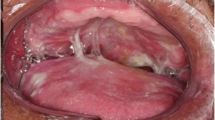Abstract
Xerostomia, or oral dryness, is one of the most common complaints experienced by patients who have had radiotherapy of the oral cavity and neck region. The hallmarks of radiation-induced damage are acinar atrophy and chronic inflammation of the salivary glands. The early response, resulting in atrophy of the secretory cells without inflammation might be due to radiation-induced apoptosis. In contrast, the late response with inflammation could be a result of radiation-induced necrosis. The subjective complaint of a dry mouth appears to be poorly correlated with objective findings of salivary gland dysfunction. Xerostomia, with secondary symptoms of increased dental caries, difficulty in chewing, swallowing and speaking, and an increased incidence of oral candidiasis, can have a significant effect on the quality of life. At present there is no causal treatment for radiation-induced xerostomia. Temporary symptomatic relief can be offered by moistening agents and saliva substitutes, and is the only option for patients without residual salivary function. In patients with residual salivary function, oral administration of pilocarpine 5–10 mg three times a day is effective in increasing salivary flow and improving the symptoms of xerostomia, and this therapy should be considered as the treatment of choice. Effectiveness of sialogogue treatment requires residual salivary function, which emphasizes the potential benefit from sparing normal tissue during irradiation. The hypothesis concerning the existence of early apoptotic and late necrotic effects of irradiation on the salivary glands theoretically offers a way of achieving this goal.
Similar content being viewed by others
Author information
Authors and Affiliations
Rights and permissions
About this article
Cite this article
Guchelaar, HJ., Vermes, A. & Meerwaldt, J. Radiation-induced xerostomia: pathophysiology, clinical course and supportive treatment. Support Care Cancer 5, 281–288 (1997). https://doi.org/10.1007/s005200050075
Issue Date:
DOI: https://doi.org/10.1007/s005200050075




